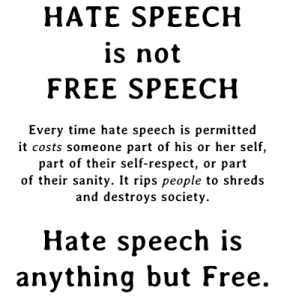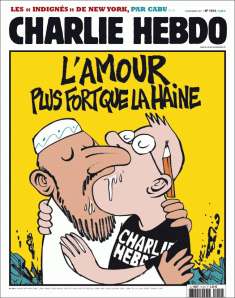 I was going to write my first post this year on future trends in 2015. Unfortunately, current events led me to postponing my predictions for 2015 for another time. Here it is, my first post in 2015: advertising and the extremist speech. January 7, 2015 a very unfortunate day in France when 12 were deadly injured in a terrorist attack at the headquarters of a satirical magazine, Charlie Hebdo. May they rest in peace. Also, these days, there is an Italian campaign against violence against women going viral on the internet. Plus, there are articles against this campaign going viral. Hate speech is dangerous, no matter where it is aimed.
I was going to write my first post this year on future trends in 2015. Unfortunately, current events led me to postponing my predictions for 2015 for another time. Here it is, my first post in 2015: advertising and the extremist speech. January 7, 2015 a very unfortunate day in France when 12 were deadly injured in a terrorist attack at the headquarters of a satirical magazine, Charlie Hebdo. May they rest in peace. Also, these days, there is an Italian campaign against violence against women going viral on the internet. Plus, there are articles against this campaign going viral. Hate speech is dangerous, no matter where it is aimed.
Charlie Hebdo is a controversial magazine and has been involved in some scandals for mocking Mohammad, accused by French Muslims to have offended their religion. I’ll leave you a video with some samples from Charlie Hebdo:
Originally, mocking immigrants has been used as a weapon to attract political sympathy. Although, a major community in France and keeping in mind France’s leftist tradition, Muslims are highly unrepresented at a political level, which, some voices claim, may be the cause of violent outbursts. Most often Muslim minorities as offered as counter examples of managing multiculturalism in international communities. For example, I have not seen a social campaign addressing the issue of Muslim communities throughout Europe. I have not seen an advertising campaign addressing social acceptance of multicultural communities. Until further notice, there is this tale about multicultural diversity I like to tell whenever I hear anyone shaming any cultural minority: France, early 2000’s. A bobo vegetarian family has a child. The child follows the educational path in his family, goes to a highly rated school in Paris, does not meet children belonging to other minorities. In some weekends the child was visiting his grandparents who were not really taking seriously the child’s dietary plan, considering meat is essential. One day, walking with his parents, the child sees an African man, asks his mother: Maman, why does that guy have the color of liver? Maman is outraged the kid knows what color a liver has. Should you be failing to understand the point of this particular story, I’ll give you a hint: segregation and also advise you to read no further.
I’ve said it before: I do believe advertising is the new policy maker. I don’t believe advertising should educate, but I do believe advertising can educate. Among the trends in marketing for 2015 I was also predicting that in the age of disruption advertising should be valuable for a customer’s time. That is, advertising should give me something in exchange for my time: even a smile, even restore my faith in humanity. Which brings me to my next point: restoring my faith in humanity, which is something an Italian campaign did for me a few days ago. You probably know it, but I’ll leave you the video:
I’ve seen people going “aw” over this video, myself included, and I’ve also seen plenty of negative reactions, this article included. Rebecca writes about advertising, but she forgets something very important in advertising: the target audience. Relevant advertising is relevant for a certain group of people. Most likely she is not part of that group. Any piece of advertising should be judged by viewers from the target group and its effectiveness in that group. Well educated urban groups may be inquiring about the objectification in that video. However, the group having the tools to pose such questions is less likely to be involved in acts of violence against women.
I had a deja vu reading Rebecca Hains’s article. I know these arguments. I have previously written on this issue: objectification is both ways. I confess, I objectify men. I like David James Gandy just because he is handsome. Also, I strongly believe that any unidirectional form of speech, any rough perspective which leaves nuances aside is a very dangerous path. There is always more that one side. It is also true, we think in categories, because categories and simplifying reality is what enables us to process information. Also, the road from a rough unidirectional point of view to a hate speech is quite short. Criticizing is always good because it brings perspectives, but Rebecca Hains seems to be a bit blinded by her feminist perception on the matter and from here to a hate speech against men…you know the path. As to children being those who deliver the message, a media expert, Rebecca should know that audiences respond very well to messages delivered by children. It might be that for the target audience a message from a person who has well researched the social matter of domestic violence is very dull and unappealing.
Advertising will not educate unless intended. Advertising can educated. Advertising has to be meaningful, that can mean also a smile. Advertising can mean steps towards changing the world, it has to be adequate to its audience. And now, I’ll leave to a piece of advertising we should see more in Europe.

